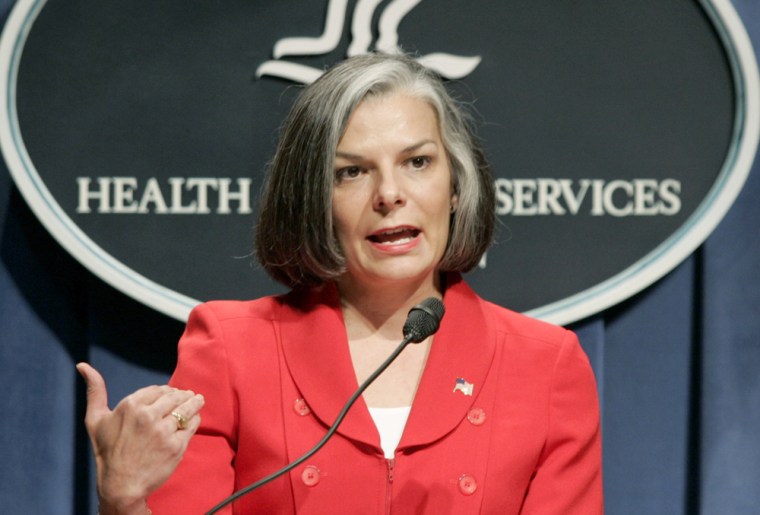The government moved Tuesday to direct scarce remaining flu shots straight to pediatricians, nursing homes and other places that care for the patients who need them most.
But only a fraction of the 22.4 million doses that maker Aventis Pasteur has yet to ship can be diverted to areas with the biggest shortages. And officials acknowledged Tuesday that even if planned rationing goes well, there will be high-risk patients who struggle to get shots but can’t find them.
“We’re sorry for the people who need flu vaccine and may not be able to get it this year,” said Dr. Julie Gerberding, director of the Centers for Disease Control and Prevention. “But we will take every step that we can take to get an equitable distribution of vaccine as quickly as we can.”
The targeted shipments come as CDC struggles to ensure that the youngest, oldest and sickest Americans — those most vulnerable to influenza — have first access to flu shots now that the nation’s supply has been cut in half.
Crackdown on price gouging
Gerberding called “heroes” those healthy adults heeding CDC’s plea to forgo flu shots this year. But, “shame on the people who are price-gouging,” she said, pledging to help state officials prosecute those caught doing so.
There have been scattered reports of price gouging since the shortage was announced, and Kansas filed a lawsuit Tuesday against Meds-Stat, a pharmaceutical distributor. Attorney General Phill Kline said Meds-Stat proposed selling the vaccine to a pharmacy in Kansas City, Kan., last Friday for $900 per vial; a week earlier, the company was selling the vaccine for $85 per vial. Each vial contains about 10 doses.
Also Tuesday, two other companies revealed they had offered the government flu vaccine originally intended for sale abroad. GlaxoSmithKline has 500,000 doses manufactured in Germany; ID Biomedical is offering 1 million to 1.5 million doses made in Canada. The Food and Drug Administration hasn’t approved either vaccine brand for sale in this country.
“It’s not easy to get unlicensed vaccine into the country in time to solve any problems this year,” Gerberding cautioned. “But we’re not ruling anything out.”
British regulators unexpectedly shut down a major U.S. vaccine supplier, Chiron Corp., last week, freezing shipment of up to 48 million expected flu shots.
That left Aventis as this year’s sole supplier of injectible flu vaccine, a total of 55.4 million doses. More than half already has been sold and shipped, mostly to private distributors — doses that can’t be yanked back, although Aventis is asking customers to share any not reserved for high-risk patients.
Distribution to take six to eight weeks
Tuesday’s plan targets Aventis’ remaining shots. A shipment of about 14.2 million doses will begin this week, headed for pediatricians’ offices, hospitals, long-term care facilities and Veterans Affairs clinics — distribution that will take six to eight weeks.
Also on the list are state health departments that had ordered supplies only from Chiron and thus haven’t yet received any doses. Gerberding wouldn’t list the states Tuesday, saying more information on when and where shipments will arrive should be available later in the week.
“Be patient,” Damian Braga, president of Aventis’ U.S. branch, urged patients and providers. Vaccine shipments normally are paced through late November, when flu season is just getting started.
But the vast majority of those now-shipping doses — 11.8 million — already were sold to high-risk providers, Braga acknowledged.
That leaves 8.2 million doses — half headed for an already planned federal stockpile — that CDC will target even more tightly. The agency is tracking vaccine shipments, the number of high-risk residents and number of flu cases county-by-county, to direct those final doses to areas most in need.
Still, 42 million to 50 million high-risk patients probably will seek flu shots this year — roughly half the number who need them — and it’s unlikely all will find one, Gerberding and Braga acknowledged.
High-risk patients who don’t get vaccinated should contact a doctor as soon as they feel flu symptoms, Gerberding urged. There are drugs that can treat influenza if taken promptly, and even prevent it when taken before infection.
Flu shots are made of killed influenza virus, and thus are recommended for high-risk patients.
The healthy do have a limited other option: the nasal spray vaccine FluMist, made of live but weakened virus. Maker MedImmune Inc. said last week it would double supplies to 2 million doses. It is to be used only by healthy 5- to 49-year-olds.
